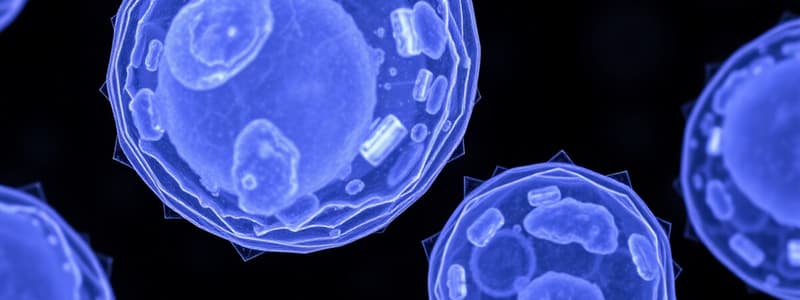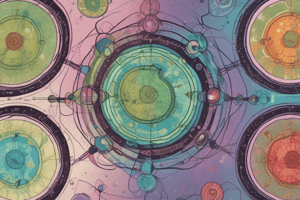Podcast
Questions and Answers
What happens during the S phase of the cell cycle?
What happens during the S phase of the cell cycle?
- The cell prepares for mitosis.
- Cellular energy is focused on growth.
- The cell size increases significantly.
- Chromosomes are duplicated. (correct)
Which checkpoint mechanism ensures readiness for DNA synthesis?
Which checkpoint mechanism ensures readiness for DNA synthesis?
- Metaphase checkpoint
- S checkpoint
- G1 checkpoint (correct)
- G2 checkpoint
What occurs during the G2 phase of the cell cycle?
What occurs during the G2 phase of the cell cycle?
- Chromosomes are actively being duplicated.
- The cell stops synthesizing DNA.
- Cell growth is maximized.
- The cell prepares to divide. (correct)
What is the duration of Interphase in the cell cycle?
What is the duration of Interphase in the cell cycle?
What happens at the Metaphase checkpoint during mitosis?
What happens at the Metaphase checkpoint during mitosis?
What is the primary function of the cell cycle?
What is the primary function of the cell cycle?
What does the 'Interphase' of the cell cycle correspond to?
What does the 'Interphase' of the cell cycle correspond to?
Which cell types are noted to be unable to divide?
Which cell types are noted to be unable to divide?
What is indicated by the G0 state in the cell cycle?
What is indicated by the G0 state in the cell cycle?
What is the significance of the cell cycle in unicellular organisms?
What is the significance of the cell cycle in unicellular organisms?
What process underlies the function of generating two identical daughter cells?
What process underlies the function of generating two identical daughter cells?
What is the primary role of the G1 phase in the cell cycle?
What is the primary role of the G1 phase in the cell cycle?
During which phase do cells replicate their DNA?
During which phase do cells replicate their DNA?
Which of the following statements about DNA replication is true?
Which of the following statements about DNA replication is true?
What is the function of the centrosome during the cell cycle?
What is the function of the centrosome during the cell cycle?
What characterizes the leading strand during DNA replication?
What characterizes the leading strand during DNA replication?
Which of the following is NOT a feature of DNA replication?
Which of the following is NOT a feature of DNA replication?
During the S phase, what happens to the duplicated chromosomes?
During the S phase, what happens to the duplicated chromosomes?
What is the first step of DNA replication?
What is the first step of DNA replication?
What are the internal control mechanisms that influence cell cycle progression primarily responding to?
What are the internal control mechanisms that influence cell cycle progression primarily responding to?
At which checkpoint does the cell cycle typically stop in response to DNA damage?
At which checkpoint does the cell cycle typically stop in response to DNA damage?
Which factor is most likely to increase the activity of Cdks and cyclins?
Which factor is most likely to increase the activity of Cdks and cyclins?
What is a primary function of cyclins in the cell cycle?
What is a primary function of cyclins in the cell cycle?
During which specific phase do the chromosomes condense and the nuclear envelope break down?
During which specific phase do the chromosomes condense and the nuclear envelope break down?
What essential role does CDK (Cyclin-Dependent Kinase) play in the cell cycle?
What essential role does CDK (Cyclin-Dependent Kinase) play in the cell cycle?
What occurs at the G2–M transition checkpoint?
What occurs at the G2–M transition checkpoint?
Which phase of the cell cycle is characterized by the synthesis of DNA?
Which phase of the cell cycle is characterized by the synthesis of DNA?
What is the primary function of cyclins in cell cycle regulation?
What is the primary function of cyclins in cell cycle regulation?
How do cancer cells typically differ from normal cells in terms of growth factor requirements?
How do cancer cells typically differ from normal cells in terms of growth factor requirements?
What role does Maturation Promoting Factor (MPF) play in the cell cycle?
What role does Maturation Promoting Factor (MPF) play in the cell cycle?
Which cyclins are involved in the G1 phase of the cell cycle?
Which cyclins are involved in the G1 phase of the cell cycle?
What abnormal characteristic may cancer cells have regarding cell cycle control systems?
What abnormal characteristic may cancer cells have regarding cell cycle control systems?
Which of the following statements about the cell cycle is true?
Which of the following statements about the cell cycle is true?
What is a key difference between cyclins and cyclin-dependent kinases (cdks)?
What is a key difference between cyclins and cyclin-dependent kinases (cdks)?
Why is the concentration of cyclins described as cyclic?
Why is the concentration of cyclins described as cyclic?
What is the primary function of the kinetochore during cell division?
What is the primary function of the kinetochore during cell division?
During which phase of mitosis do chromosomes line up in the center of the cell?
During which phase of mitosis do chromosomes line up in the center of the cell?
What occurs during the anaphase of mitosis?
What occurs during the anaphase of mitosis?
Which checkpoint prevents progress past metaphase until all kinetochores are attached to microtubules?
Which checkpoint prevents progress past metaphase until all kinetochores are attached to microtubules?
What is the main event during telophase?
What is the main event during telophase?
Which process directly follows mitosis in the cell cycle?
Which process directly follows mitosis in the cell cycle?
What role does the cell cycle control system serve?
What role does the cell cycle control system serve?
What are daughter cells formed from mitosis expected to do next?
What are daughter cells formed from mitosis expected to do next?
Which structure organizes the spindle fibers during cell division?
Which structure organizes the spindle fibers during cell division?
What characterizes interphase G2 stage?
What characterizes interphase G2 stage?
Flashcards
G1 Phase
G1 Phase
The first gap phase in the cell cycle where the cell grows and prepares for DNA replication.
S Phase
S Phase
The synthesis phase in the cell cycle where DNA replication occurs.
G2 Phase
G2 Phase
The second gap phase in the cell cycle where the cell prepares for mitosis.
M Phase (Mitosis)
M Phase (Mitosis)
Signup and view all the flashcards
Checkpoint Control Mechanisms
Checkpoint Control Mechanisms
Signup and view all the flashcards
What is the cell cycle?
What is the cell cycle?
Signup and view all the flashcards
Why does cell division occur?
Why does cell division occur?
Signup and view all the flashcards
What is Interphase?
What is Interphase?
Signup and view all the flashcards
What is M phase?
What is M phase?
Signup and view all the flashcards
What is G0 phase?
What is G0 phase?
Signup and view all the flashcards
What is G1 phase?
What is G1 phase?
Signup and view all the flashcards
What is S phase?
What is S phase?
Signup and view all the flashcards
What is G2 phase?
What is G2 phase?
Signup and view all the flashcards
What is the G1 stage?
What is the G1 stage?
Signup and view all the flashcards
What does the G1 checkpoint ensure?
What does the G1 checkpoint ensure?
Signup and view all the flashcards
Why is DNA replication important for cell division?
Why is DNA replication important for cell division?
Signup and view all the flashcards
What is the key feature of DNA replication?
What is the key feature of DNA replication?
Signup and view all the flashcards
How does DNA replication proceed?
How does DNA replication proceed?
Signup and view all the flashcards
Explain the directionality of DNA replication.
Explain the directionality of DNA replication.
Signup and view all the flashcards
What are sister chromatids?
What are sister chromatids?
Signup and view all the flashcards
Why is the centrosome duplicated during the S phase?
Why is the centrosome duplicated during the S phase?
Signup and view all the flashcards
Centrioles
Centrioles
Signup and view all the flashcards
Prophase
Prophase
Signup and view all the flashcards
Metaphase
Metaphase
Signup and view all the flashcards
Anaphase
Anaphase
Signup and view all the flashcards
Telophase
Telophase
Signup and view all the flashcards
Cytokinesis
Cytokinesis
Signup and view all the flashcards
Kinetochore
Kinetochore
Signup and view all the flashcards
G2 Checkpoint
G2 Checkpoint
Signup and view all the flashcards
What are Cyclins?
What are Cyclins?
Signup and view all the flashcards
What are Cyclin-Dependent Kinases (Cdks)?
What are Cyclin-Dependent Kinases (Cdks)?
Signup and view all the flashcards
What is a Cyclin-Cdk Complex?
What is a Cyclin-Cdk Complex?
Signup and view all the flashcards
What is Maturation Promoting Factor (MPF)?
What is Maturation Promoting Factor (MPF)?
Signup and view all the flashcards
How does cancer relate to the cell cycle?
How does cancer relate to the cell cycle?
Signup and view all the flashcards
What are cell cycle checkpoints?
What are cell cycle checkpoints?
Signup and view all the flashcards
What is the G0 phase?
What is the G0 phase?
Signup and view all the flashcards
What is the cell cycle control system?
What is the cell cycle control system?
Signup and view all the flashcards
What is a CDK?
What is a CDK?
Signup and view all the flashcards
What is a Positive Cue?
What is a Positive Cue?
Signup and view all the flashcards
What is a Negative Cue?
What is a Negative Cue?
Signup and view all the flashcards
What occurs at the G1 Checkpoint?
What occurs at the G1 Checkpoint?
Signup and view all the flashcards
What occurs at the G2 Checkpoint?
What occurs at the G2 Checkpoint?
Signup and view all the flashcards
What occurs at the Metaphase Checkpoint?
What occurs at the Metaphase Checkpoint?
Signup and view all the flashcards
Study Notes
Course Details
- Course title: The Human Body PJ1311
- Topic: The Cell Cycle and its Control
- Lecturer: Dr Lamia Kandil
- Lecturer of Pharmacy Practice, PhD, FHEA
- MB138
- Email: [email protected]
- vevox.app ID: 102-353-245
Kandil Lectures
- 3 lectures on Genomics
- Introduction to Genomics
- The central dogma of life (Transcription, Translation)
- Cell cycle and control mechanism
The Cell Cycle
- All cells are derived from pre-existing cells
- Cell cycle: ordered series of events preparing for cell division
- Functions of the cell cycle
- Copying cellular components & DNA duplication
- Dividing the cell evenly into daughter cells
- "Cell cycle": alternating "growth" and "division" of the cell.
- Cell division is a part of the cell cycle.
Why Cell Division Occurs
- In unicellular organisms, division of one cell reproduces the entire organism (reproduction)
- Multicellular organisms depend on cell division for
- Growth (increase in numbers)
- Maintaining and repairing cells (e.g., liver, skin)
- Not all cells divide
- Some cells can't divide (e.g., eye lens, nerve, heart cells). These cells are maintained.
Cell Cycle Basic Function
- "Growth" activity corresponds to "Interphase"
- Cell growth and copying of chromosomes in preparation for cell division (mitosis and cytokinesis)
- "Division" activity corresponds to "M phase"
Stages of the Cell Cycle
- Interphase (G1, S, G2)
- G1: Cell growth, normal cell function, organelle duplication, proteins synthesis. G1 checkpoint
- S: DNA replication
- G2: Continued growth, organelles and proteins synthesis. G2 checkpoint
- Mitosis (prophase, prometaphase, metaphase, anaphase, telophase, cytokinesis)
- Prophase: Chromosomes condense, nuclear membrane breaks down, spindle forms
- Prometaphase: Chromosomes attach to spindle microtubules. Nuclear envelope fragments
- Metaphase: Chromosomes align at the metaphase plate
- Anaphase: Sister chromatids separate and move to opposite poles
- Telophase: Chromosomes decondense, nuclear envelopes reform.
- Cytokinesis: Cytoplasm divides, producing two daughter cells. Note: Mitosis doesn't include cytokinesis
Interphase Details
- Interphase: about 90% of the cell cycle
- G1 phase: First gap, cell growth
- S phase: Synthesis, DNA replication (longest phase)
- G2 phase: Second gap, cell prepares to divide
G1 Phase Details
- First stage of cell growth after cell replication occurs.
- Preparation of chromosomes for replication
- Duplication of cellular components (cytoplasm and organelles).
- Cell carries out its usual metabolic activities
- G1 checkpoint (restriction point): Cell commits to division or exits from the cell cycle.
S Phase Details
- Instructions for making cell parts are encoded in DNA
- Each new cell needs a complete set of DNA molecules
- DNA must be copied (replicated) before cell division.
DNA Replication
- DNA replication is semiconservative.
- Watson and Crick base pairing is maintained during replication.
- Synthesis of new DNA strands occurs in the 5' to 3' direction.
- DNA replication is a multi-enzymatic process initiated when a primer is required. Several enzymes and proteins (Replisome) are involved in the initiation process.
- Enzymes involved in DNA replication: - Helicase, Binding protein, Primase, DNA polymerase, DNA polymerase I, Ligase
- Replication of DNA: Base pairing allows each strand to serve as a template for a new strand.
Stages of DNA Replication
- The initiation phase
- Elongation phase (Leading and Lagging strand synthesis)
- Termination phase
S Phase - Duplicated Chromosomes
- Duplicated chromosomes are called chromatids
- Chromatids are held together by a centromere
S Phase - Centrosome Duplication
- Centrosome is near the nucleus in animal cell
- Contains microtubule organizing center (MTOC) and two centrioles
- Protein surrounding centrioles that migrate to poles before cell division.
Mitosis
- Mitosis: process separating chromosomes in the cell nucleus into two identical sets in two nuclei
- During mitosis, pairs of chromosomes condense.
- Sister chromatids attach to fibers that pull them to opposite sides of the cell.
- Cytokinesis follows mitosis.
Phases of Mitosis
- Prophase
- Prometaphase
- Metaphase
- Anaphase
- Telophase
- Cytokinesis
Prometaphase (Late Prophase)
- Nuclear membrane and nucleolus break down
- Chromosomes continue condensing and become clearly visible
- Spindle fibers attach to the chromosomes at the centromere
Telophase
- Prophase is essentially reversed.
- Sister chromatids are at opposite poles
- Nuclear envelope forms around each set of sister chromatids and chromosomes condense
- Nucleolus reappears and interphase cellular functions resume
Cytokinesis
- Cytoplasm division
- Divides the cell into two daughter cells (cytoplasm, organelles)
- Cytokinesis begins in telophase and ends shortly thereafter (part of M phase but not mitosis)
Daughter Cells of Mitosis
- Have the same number of chromosomes as the parent cell.
- Identical to each other
- Must grow in size (G1 of Interphase) to become mature
- Ready to enter a new cell cycle
Cell Cycle Control System
- The sequential events of the cell cycle are controlled by a cell cycle control system, similar to a clock
- Controlled by internal and external controls
- Checkpoints in the clock where the cell cycle stops until a go-ahead signal is received.
Cancer Cells
- Cancer cells do not respond normally to the body's control mechanisms.
- They may not need growth factors to grow and divide
- They may make their own growth factors
- They may convey a growth factor's signal without the presence of the growth factor
- May have an abnormal cell cycle control system
Cyclins and Cyclin-Dependent Kinases (Cdks)
- Cyclins: family of proteins activating cyclin-dependent kinase (Cdk) enzymes. Examples: Cyclin A, Cyclin B, Cyclin D, Cyclin E
- Cyclin-Dependent Kinases (Cdks): Family of protein kinases regulating cell cycle, including cdk1, cdk2, cdk4, cdk6
- Maturation Promoting Factor (MPF): Heterodimeric protein composed of cyclin B & cyclin-dependent kinase (CDK1), promoting entrance into mitosis (M phase) from G2 phase, phosphorylating multiple proteins needed during mitosis.
Important Videos (URLs)
- List of URLs for videos provided for further learning.
Important Cell Cycle Checkpoints
- G1 checkpoint: Cell growth, DNA damage, adequate resources.
- G2 checkpoint: DNA replication, damage.
- M checkpoint (spindle checkpoint): Ensures all chromosomes are properly attached to the spindle fibers in metaphase before anaphase.
Purpose of Cell Cycle in Eukaryotic Cells
- Main purpose: Cell division. Additional minor purposes are DNA replication and cell growth.
Phase of Cell Cycle and DNA Replication
- S phase is responsible for DNA replication.
Phase of Cell Cycle and Chromosome Condensation and Breakdown of Nuclear Envelope
- Prophase is the stage where chromosomes condense, and the nuclear envelope breaks down.
Molecule Responsible for Driving Cell Cycle Progression
- CDK (Cyclin-Dependent Kinase) phosphorylates target proteins.
G2 Checkpoint Function
- Checks for DNA damage and repairs it. This checkpoint ensures the cell only goes into mitosis if DNA is undamaged and properly replicated.
Cancer and Normal Cell Cycle Control
- In cancer, the normal control mechanisms of the cell cycle are lost or disrupted.
Studying That Suits You
Use AI to generate personalized quizzes and flashcards to suit your learning preferences.




